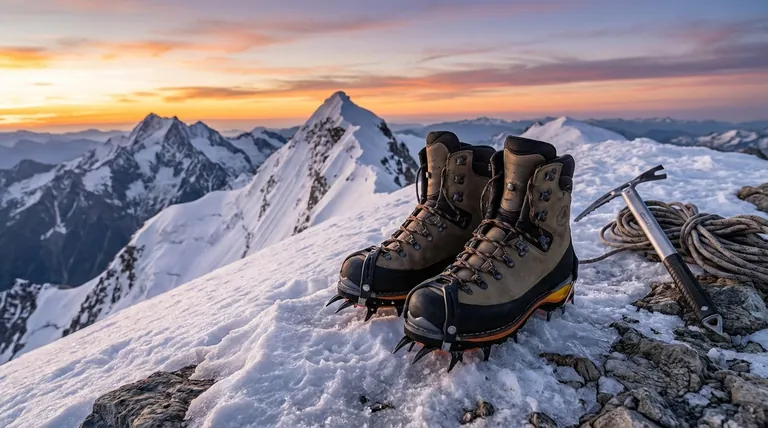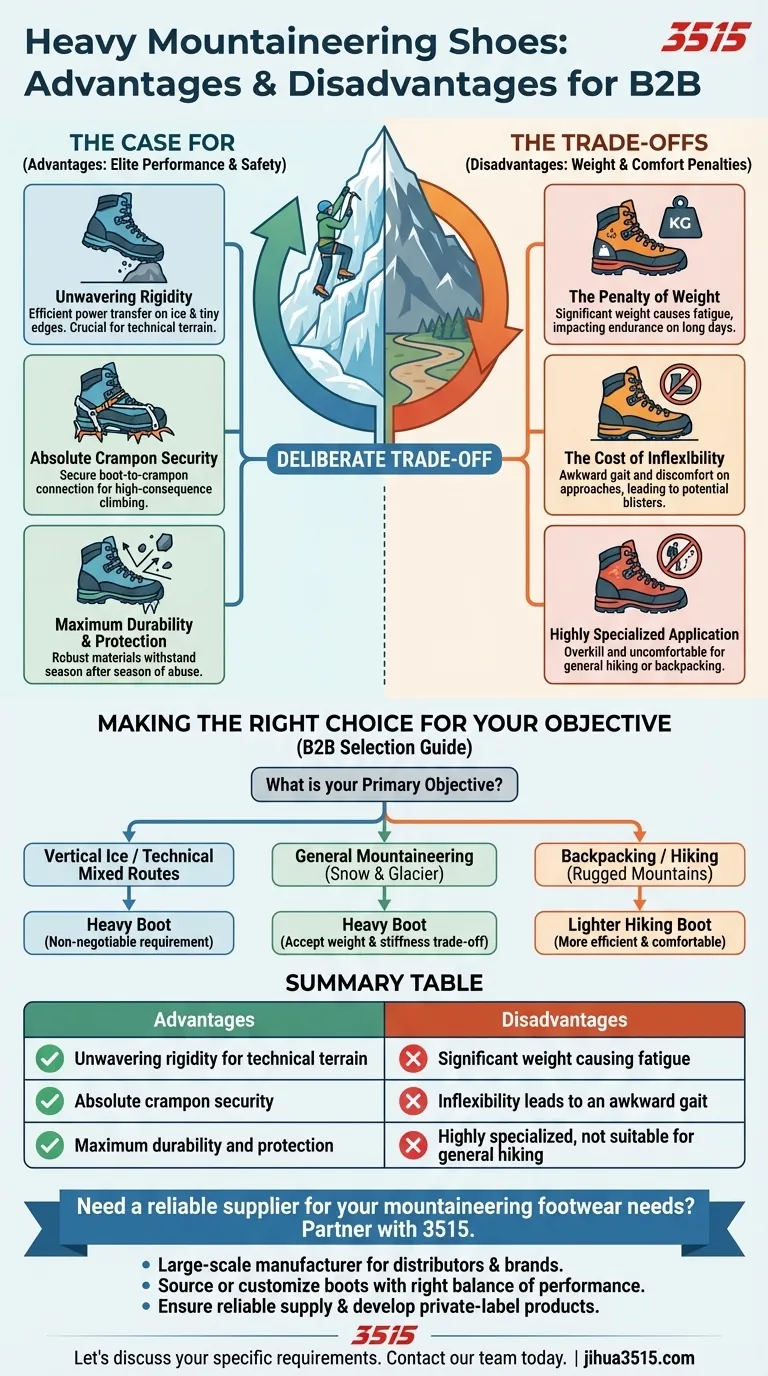The primary advantage of heavy mountaineering shoes is their absolute rigidity, which provides the necessary support and security for technical terrain like ice and steep snow. Their main disadvantages are their significant weight and lack of flexibility, making them fatiguing and uncomfortable for general hiking or long approaches on trails.
Choosing a heavy mountaineering boot is a deliberate trade-off. You are accepting significant penalties in weight and walking comfort in exchange for elite performance and safety in vertical or highly technical mountain environments.

The Case for Heavy Mountaineering Boots
Heavy mountaineering boots are not just footwear; they are specialized tools. Their design features are intentionally extreme to meet the demands of environments where failure is not an option.
Unwavering Rigidity for Technical Terrain
The most defining characteristic is a completely rigid sole. This stiffness is not a flaw; it's a critical feature.
It allows you to kick the front points of your crampons into hard ice or stand on tiny rock edges without the boot flexing and your foot losing its purchase. This transfers power directly from your leg to the terrain with maximum efficiency.
Absolute Crampon Security
These boots feature rigid plastic or leather welts on both the toe and heel. This allows them to accept "step-in" or "fully automatic" crampons.
This system provides the most secure and reliable boot-to-crampon connection possible, which is essential for preventing movement or detachment during high-consequence activities like ice climbing.
Maximum Durability and Protection
The weight of these boots comes from robust materials—thick leather or synthetic uppers, full rubber rands, and heavy-duty soles.
This construction provides exceptional protection from rockfall, ice chunks, and abrasion. They are built to withstand season after season of abuse in the harshest conditions.
Understanding the Trade-offs and Limitations
The very features that make these boots excel in technical terrain become significant liabilities when you are not on that terrain.
The Penalty of Weight
The most obvious disadvantage is the weight. Lifting a heavy, rigid boot thousands of times over a long day requires significantly more energy than walking in a lighter, more flexible shoe.
This added weight directly contributes to fatigue, slowing your pace and potentially impacting your endurance and safety on multi-day objectives.
The Cost of Inflexibility
A rigid sole prevents the natural rolling motion of your foot used for walking. On flat or rolling trails, this results in an awkward, clunky gait.
This unnatural motion is not only inefficient but can also lead to discomfort, hot spots, and blisters, especially on the long approach marches common in mountaineering.
A Highly Specialized Application
These boots are purpose-built for a very narrow range of activities. Their design is optimized exclusively for steep snow, glacier travel, ice climbing, and mixed rock-and-ice routes.
Using them for general hiking or backpacking is a mistake. They are overkill for the terrain and will only result in unnecessary weight and discomfort compared to a standard hiking boot.
Making the Right Choice for Your Objective
Selecting the right footwear comes down to honestly assessing your intended use.
- If your primary focus is vertical ice climbing or technical mixed routes: The rigidity and secure crampon compatibility of a heavy boot are non-negotiable requirements for performance and safety.
- If your primary focus is general mountaineering on snow and glaciers: These boots provide the necessary support and warmth, but you must be prepared for their weight and stiffness on the approach.
- If your primary focus is backpacking or hiking, even in rugged mountains: A heavy mountaineering boot is the wrong tool; a lighter, more flexible hiking boot will be far more comfortable and efficient.
Ultimately, you must match the capability of your boot to the demands of your objective.
Summary Table:
| Advantages | Disadvantages |
|---|---|
| Unwavering rigidity for technical terrain | Significant weight causing fatigue |
| Absolute crampon security | Inflexibility leads to an awkward gait |
| Maximum durability and protection | Highly specialized, not suitable for general hiking |
Need a reliable supplier for your mountaineering footwear needs?
As a large-scale manufacturer, 3515 produces a comprehensive range of high-performance footwear for distributors, brand owners, and bulk clients. Our production capabilities encompass all types of specialized shoes and boots, including durable mountaineering footwear built to withstand the harshest conditions.
We can help you:
- Source or customize boots with the right balance of rigidity, durability, and performance.
- Ensure reliable supply for your inventory with our large-scale production capacity.
- Develop private-label products tailored to your brand and market demands.
Let's discuss your specific requirements. Contact our team today to explore how we can support your business.
Visual Guide

Related Products
- Factory-Direct Wholesale Canvas Boots with High-Traction Rubber Soles
- Wholesale High-Traction Camo Boots - Custom Manufacturer for Brands
- Safety Footwear Wholesale Manufacturer for Custom OEM/ODM Production
- Premium Wholesale Waterproof Safety Boots High Performance Protection for Industrial Markets
- High-Traction Suede Tactical Boots Wholesale & Custom Manufacturing
People Also Ask
- Why is rubber a popular material for shoe soles? Unbeatable Grip, Durability & Value
- Why is rubber commonly used for non-slip soles? The Science of Superior Grip
- What is a vulcanized sole? Discover the Secret to Superior Flexibility and Grip
- What should be avoided when storing boots with outsoles? Protect Your Investment from Dry Rot & Decay
- What types of rubber are typically employed in non-slip footwear soles? Your Guide to Maximum Grip and Safety



















